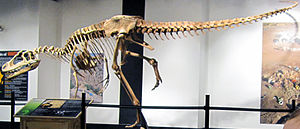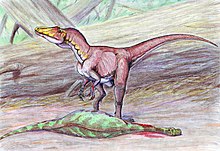Deltadromeus
| Deltadromeus | ||||||||||
|---|---|---|---|---|---|---|---|---|---|---|

Skeletal cast of Deltadromeus in the Montshire Museum of Science in Norwich . |
||||||||||
| Temporal occurrence | ||||||||||
| Upper Cretaceous (Lower Cenomanian ) | ||||||||||
| 100.5 to 96.2 million years | ||||||||||
| Locations | ||||||||||
|
||||||||||
| Systematics | ||||||||||
|
||||||||||
| Scientific name | ||||||||||
| Deltadromeus | ||||||||||
| Sereno et al. , 1996 | ||||||||||
| Art | ||||||||||
|
||||||||||
Deltadromeus is a little-known genus of theropod dinosaur from the early Upper Cretaceous (early Cenomanian ) Africa. Although it was originally described as a representative of the Coelurosauria , it is now considered a representative of the Ceratosauria . The only species is Deltadromeus agilis .
Paul Sereno and colleagues (1996) described Deltadromeus on the basis of a fragmentary, skullless skeleton that originated in the Kem-Kem beds in southwestern Morocco . In addition to this skeleton, these researchers assigned another fragmentary skullless skeleton to this genus, which originated in the Bahariya Formation in Egypt . This skeleton was previously attributed to Bahariasaurus , but has now been destroyed.
The name Deltadromeus ( Greek delta (Greek letter), dromeus - "runner") means something like "delta runner" and is intended on the one hand to refer to the layer of finds, which are interpreted as deposits of a river delta , and on the other hand to the a fast run adapted hind legs.
Features and demarcation
Deltadromeus was a theropod adapted to fast running, as indicated by the length proportions of the leg bones. The leg bones are also very thin: in relation to the bone length they are about as thick as those of Ornithomimus , but only reach 50 to 60% of the thickness of Allosaurus .
The holotype specimen discovered in Morocco is estimated to be 8 meters long, whereas the specimen from Egypt was significantly larger and is estimated to be 11 meters long.
This genus can be distinguished from other representatives of the Ceratosauria by the wide square spinous processes of the anterior caudal vertebrae, a depression on the anterior edge of the raven bone (coracoid), the dorsoventrally narrowed middle shaft of the ischium and the reduced distal articular knot of the fourth metatarsal bone.
Carrano and colleagues (2008) note that Deltadromeus cannot be clearly differentiated from Bahariasaurus on the basis of the available fossils , which means that it is possible that both genera are identical. More fossil finds are needed to clear up this problem.
Systematics
The relationship of this genus is controversial. While it was initially often attributed to the Coelurosauria , more recent studies assume that it is a representative of the Ceratosauria. Wilson (2003) and Sereno and colleagues (2004) classify Deltadromeus as a basal (original) representative of the Noasauridae , a group of the Abelisauroidea within the Ceratosauria. Carrano and Sampson (2008) and Xu and colleagues (2009) meanwhile come to the conclusion that Deltadromeus was a basic representative of the Ceratosauria outside of the Abelisauroidea.
Web links
Individual evidence
- ^ A b Gregory S. Paul : The Princeton Field Guide To Dinosaurs. Princeton University Press, Princeton NJ et al. 2010, ISBN 978-0-691-13720-9 , p. 77, online .
- ↑ a b c d e Paul C. Sereno, Didier B. Dutheil, Mohamed Iarochene, Hans CE Larsson, Gabrielle H. Lyon, Paul M. Magwene, Christian A. Sidor, David J. Varricchio, Jeffrey A. Wilson: Predatory Dinosaurs from the Sahara and Late Cretaceous Faunal Differentiation. In: Science . Vol. 272, No. 5264, 1996, pp. 986-991, doi : 10.1126 / science.272.5264.986 .
- Jump up ↑ a b c d e Matthew T. Carrano, Scott D. Sampson: The Phylogeny of Ceratosauria (Dinosauria: Theropoda). In: Journal of Systematic Palaeontology. Vol. 6, No. 2, 2008, ISSN 1477-2019 , pp. 183-236, doi : 10.1017 / S1477201907002246 .
- ↑ Ben Creisler: Dinosauria Translation and Pronunciation Guide. Archived from the original on July 10, 2011 ; accessed on August 5, 2014 .
- ↑ Xing Xu , James M. Clark , Jinyou Mo, Jonah Choiniere, Catherine A. Forster, Gregory M. Erickson, David WE Hone, Corwin Sullivan, David A. Eberth, Sterling Nesbitt, Qi Zhao, Rene Hernandez, Cheng-kai Jia , Feng-lu Han, Yu Guo: A Jurassic ceratosaur from China helps clarify avian digital homologies. In: Nature . Vol. 459, No. 7249, 2009, pp. 940-944, doi : 10.1038 / nature08124 .
